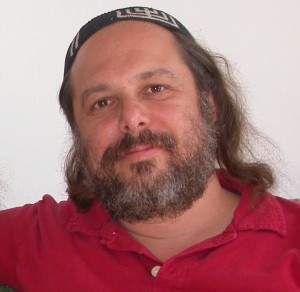On Wednesday nights, I host a biblical Hebrew class. We learn a little grammar and then we look at some biblical text. This past week, Ester, Melanie, Natasha, and myself looked at the first version of the weekly Torah portion (parsha) called Noah (Genesis/Breisheit 6:9).
The common translation of this verse is: These are the generations of Noah, Noah was a righteous/tzadik and wholehearted/tamim man in his generation; he walked with Hashem (god). Looking at the Hebrew, we had some questions. The first is why is righteous/tzadik singular, and wholehearted/tamim plural? The other question we had is with the word walk/heet-halech which is a reflexive form of the word. Why does the Torah use the reflexive form when the simple form would have worked just fine?
The answer we came up with has to do with the repetition of Noah’s name. There are a few places where a person’s name is doubled: Moshe in Exodus/Shmot 3:4, Avraham in Genesis/Breisheit 22:11 and 25:19, and Yaakov/Jacob in Genesis/Breisheit 46:2. I learned that when a name is doubled, the Torah is talking about the higher aspect of a person and their lower aspect. Often, we find ourselves in either a state of expanded consciousness, where we feel connected to everything and we understand the grand scheme of things, or we are in constricted consciousness, where we don’t understand why things are happening to us and we only care about ourselves. When the Torah repeats a name like this, it is trying to teach us something about being in both states at the same time. And in our verse, we have Noah’s name repeated. So the question is what is the Torah trying to teach us?
In order to answer this, we need to look at the word tamim. Tamim does not just mean wholesome. It means something so complete, it becomes a simple unity. Think of Forrest Gump as an example. Forrest Gump was simple, whole, and complete, and from this he came across as naive. But he wasn’t naive so much as he was being complete true to himself and when a person can get to that state, they appear as simple, almost innocent. This is the meaning of the word tam. Tamim, though is plural. Why? The answer the four of us came with is that tamim is referring to the unification of the higher and lower aspects of Noach, that they became joined and unified in a tam way. And when that happened, the unified Noah was a tzadik, singular, because he is now one – higher and lower unified into a simple unity.
And this becomes the teaching of the verse, and the answer to our second question (regarding heet-halech): when a person can join his higher and lower selves into a simple, unified, and whole being, that person becomes righteous and then that person walking with themselves, can also walk with Hashem.
About the Author
 Shmuel Shalom Cohen spent 10 years studying Torah in Jerusalem. Six years ago, he started Conscious Torah to help Jews connect to their tradition in ways they didn’t think possible. Shmuel also started, and is the executive directory of Jewish Events Willamette-valley, a non-profit whose mission is to build Jewish community, pride, and learning. In his free time, Shmuel likes walks in nature, playing music, writing poetry, and time with good friends.
Shmuel Shalom Cohen spent 10 years studying Torah in Jerusalem. Six years ago, he started Conscious Torah to help Jews connect to their tradition in ways they didn’t think possible. Shmuel also started, and is the executive directory of Jewish Events Willamette-valley, a non-profit whose mission is to build Jewish community, pride, and learning. In his free time, Shmuel likes walks in nature, playing music, writing poetry, and time with good friends.